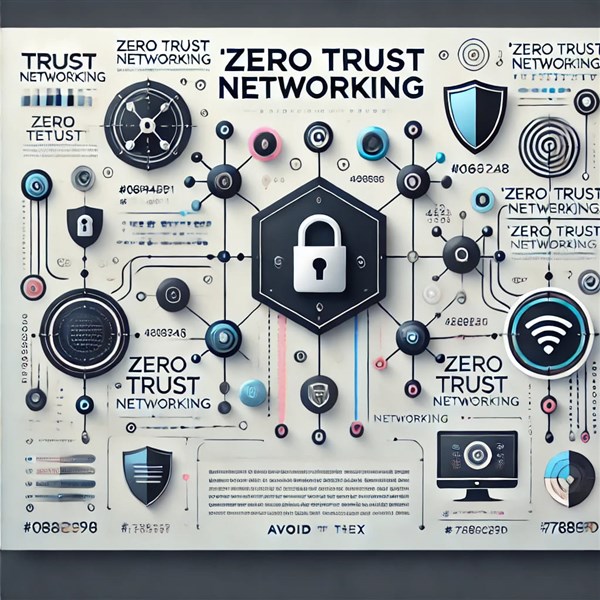We're open through the holidays to support your upskilling goals — book your session today!
We're open through the holidays to support your upskilling goals — book your session today!
Unable to find what you're searching for?
We're here to help you find it
In a world where data breaches and cyber-attacks are becoming increasingly sophisticated, securing an organization’s data and systems has never been more critical. Traditional perimeter-based security models are proving insufficient as organizations adopt cloud services, remote work, and bring-your-own-device (BYOD) policies. This is where Zero Trust Networking comes in—a cybersecurity approach that fundamentally changes how access and security are managed across digital assets. By adopting a “never trust, always verify” philosophy, Zero Trust minimizes risk, protects valuable assets, and ensures compliance with stringent data protection regulations. This article explores the significant benefits of implementing a Zero Trust Network model within your organization.
Zero Trust Networking is designed to reduce vulnerabilities at every access point, which is crucial for protecting sensitive data. Unlike traditional security models that allow unrestricted access to users inside the corporate network, Zero Trust assumes that every user, device, and connection could potentially be a threat. Consequently, all interactions are authenticated, authorized, and encrypted.
Benefits of Enhanced Data Protection:
For industries dealing with confidential information, such as finance, healthcare, and government, Zero Trust adds an essential layer of security that’s both proactive and responsive to emerging threats.
Insider threats—whether due to negligence or malicious intent—can be one of the hardest security risks to mitigate, especially in organizations with open-access models. By assuming no user or device is inherently trustworthy, Zero Trust Networking minimizes the damage an insider could cause.
How Zero Trust Reduces Insider Threats:
Zero Trust’s meticulous access control and behavior monitoring significantly reduce the chance of data breaches stemming from insider threats, whether accidental or deliberate.
With data privacy regulations such as GDPR, CCPA, and HIPAA setting high standards for data protection, organizations are under increased pressure to manage sensitive information responsibly. Zero Trust Networking provides a structured framework that helps meet compliance requirements, mitigating risks associated with non-compliance.
Benefits of Zero Trust for Compliance:
By building compliance into the security framework, Zero Trust not only keeps your organization aligned with legal standards but also fosters trust among clients and partners who rely on your commitment to data protection.
Traditional security models often leave security blind spots, especially in hybrid cloud or multi-cloud environments. Zero Trust Networking, however, provides comprehensive visibility into every device, user, and application connected to the network, allowing security teams to monitor and manage access in real-time.
How Zero Trust Improves Network Visibility:
This level of visibility is invaluable, particularly for organizations with remote workforces or complex IT environments, as it allows for faster detection and mitigation of potential threats.
In traditional security models, if a malicious actor breaches the perimeter, they may gain access to a vast portion of the network. Zero Trust limits this damage through micro-segmentation and least-privilege access.
Benefits of Reduced Breach Impact:
Organizations implementing Zero Trust can significantly reduce the cost and impact of data breaches, both financially and in terms of reputational damage.
As organizations increasingly adopt remote and hybrid work models, security must adapt to protect users working outside the traditional office network. Zero Trust Networking is designed to secure assets regardless of their location, making it an ideal model for today’s flexible workforce.
Advantages of Zero Trust for Remote Work:
Zero Trust’s adaptability ensures that remote work environments are as secure as traditional office settings, allowing employees to work efficiently without increasing security risks.
Although implementing Zero Trust may initially require investment, it is a cost-effective strategy in the long run due to its efficient and comprehensive security coverage.
Cost Benefits of Zero Trust:
Organizations with a Zero Trust approach often see a better return on investment in cybersecurity, given the reduced risk of costly breaches and optimized resource allocation.
Conclusion
In today’s evolving digital landscape, Zero Trust Networking is a proactive approach to securing data, applications, and devices against threats that can come from any direction. From enhanced data protection and reduced insider risks to improved regulatory compliance and cost savings, the benefits of Zero Trust Networking make it an essential framework for organizations of all sizes. While the transition may involve an initial investment, the long-term advantages far outweigh the costs, making Zero Trust a strategic, forward-thinking approach to cybersecurity.
Organizations prioritizing Zero Trust are better equipped to handle security challenges, instilling confidence in clients, partners, and stakeholders that their data and systems are protected at every layer. For any company looking to stay competitive, compliant, and secure, adopting Zero Trust Networking isn’t just a recommendation—it’s a necessity for robust and future-proof cybersecurity.
If you're interested in implementing Zero Trust Networking in your organization, it's essential to have the right skills and knowledge. Koenig Solutions, a leading IT training company, offers a range of courses on Zero Trust Networking and other top technology certifications. Enroll in a course today to enhance your expertise and boost your organization's network security.

Aarav Goel has top education industry knowledge with 4 years of experience. Being a passionate blogger also does blogging on the technology niche.










